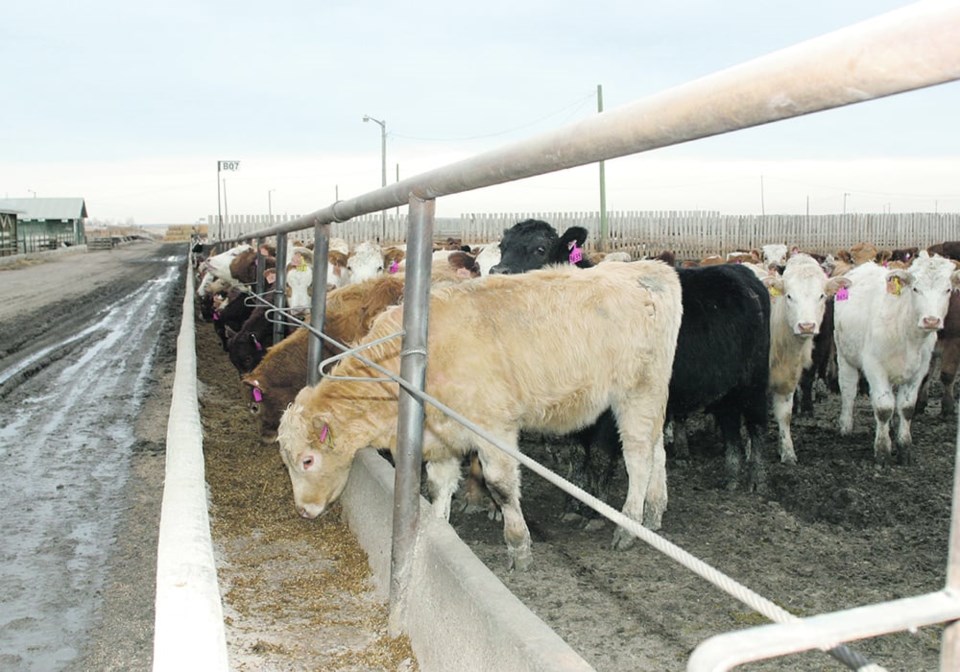REDVERS, Sask. — Record feeder steer prices are tempting purebred bull producers to sell some of their stock to the feeder market this fall.
“The markets are looking really strong for feeder calves. If I can sell my male calves as $2,000 feeder steers, I’m really tempted to sell more of them that way and sell less bulls next year,” said Sheldon Kyle of Kenray Ranch near Redvers, Sask.
“There’s been some good bull sales but overall, I’d say they haven’t kept pace with the feeder calf price.”
In a typical year, Kenray sells 45 to 50 bulls but may trim that to 30.
“I’m going to sell the rest of the steers as feeder calves in the fall and not have the expense of developing them, feeding them or warrantying them because a lot of guys expect full warranty on bulls they buy for that first year,” he said.
Kyle said buyers don’t seem as eager to spend in today’s market.
“They’re kind of stuck in the old mentality of bulls should be worth $5,500 even though a lot of those calves are going to be pushing that $2,000 mark this fall.”
More people raised bulls in the years following BSE because higher prices were available compared to feeders, he added.
“I’d almost argue now that the rules have reversed. There’s more money in feeder cattle than there is in selling breeding stock.”
Kyle has noted strong bull sales this spring, including his own, but many operations have leftovers.
“That’s because of oversupply in the marketplace. There are more people selling bulls than there are commercial cattle available that are needing bulls.”
As feed costs rise, it becomes more expensive to raise bulls to maturity.
“The bottom line always comes back to economics, which is going to drive the decision,” said Anne Wasko, market analyst for Gateway Livestock Exchange based in Taber, Alta.
“We’ve got record prices and record costs of production. So when a producer sits down and does the math, whether it’s to develop a replacement heifer, to develop a purebred bull, whatever his normal program is, it’s always at the top to look at the numbers,” said Wasko.
“The numbers right now, given record costs of production of developing these bulls … that’s obviously the signal.
“Don’t forget that our cow herd is getting smaller and therefore, we require less bulls, so the demand is less. We’re going to have less feeder cattle. Somewhere, some pens are going to go empty. I tell that to cattle feeders all the time going into this phase. But the same things are going to happen on the bull side. Somebody’s going to have to produce less bulls,” she said.
Brenna Grant, executive director of Canfax, agreed that this year’s high prices will prompt some producers to sell.
“This is the same conversation that cow-calf producers will be having about heifers and the question of do they retain replacement heifers in the herd, or do they sell them this fall given the high prices?” she said.
“The last time we had a spike in prices was 2014-15 and at that point we also saw opportunistic selling in terms of producers saying that they would sell and take their money out of the market versus taking the risk of prices dropping in the future if they retained ownership and incurred the cost of feed.”
Added Wasko: “The last time we had record feeder cattle prices was 2015 and the same thing happened then. Bulls were put into the feeder steer market at that point in time too.”
Jason Frey of Freyburn Angus at Oxbow, Sask., is also aware of shrinking margins on his purebred and commercial operation.
“It’s been tossed around here the last couple years,” he said of selling into the feeder market. “It’s definitely going to factor this fall if prices can stay where they’re at. If (bull) prices drop off, then it’s a definite consideration. Nothing’s set in stone. The margins are tight on the cattle industry, no matter if you’re on the purebred or the commercial side,” he said.
“Fat bulls are in that $1.50 up to $1.60 a pound. Lots of mature bulls are 2,500 to 2,700 lb. So they’re in the ballpark of $4,000 for an old bull. Calf-wise, I’ve been hearing they’re in that vicinity right now of $1,800 to $1,900,” he said.
“We sold a handful (of bulls) up to $10,000 this year, but we sold lots for $4,000 to $4,200, and then there are the ones you don’t sell.”
Frey said feed, supplements, DNA tests, semen tests and veterinary bills are additional costs when developing bulls.
“Getting into your bull sale side of things, you’ve got video and picture expenses, catalogue expenses, auctioneers and all those types of sales expenses,” he said.
“It’s always interesting because you hear these great big high dollar bull sales. It would be really interesting to see the actual deposit at the end of the day.”
Insurance and warranties also add to costs and risk.
“As far as the pedigree act is concerned, if you’re selling a bull, you are legally guaranteeing him to be a breeding bull. So if something is wrong, you have to legally stand behind them…. It used to be years ago guys were loyal customers, but it doesn’t seem to be the case anymore.”
Breeders may start with 100 bulls in fall but culling for quality and genetics reduces the number available for eventual sale, he noted.
“If you were to sell that whole pen of 100 as steers at $2,000 apiece, you’re done. You don’t have to feed them, you don’t have any deaths or illness loss because they’re done and gone.”
Added Wasko: “If you look at some of the internet sales that are going on today, for a fall delivery you’re getting prices up into that $2,600 area.
“So the fall projections for yearling cattle coming off grass are very strong.”



